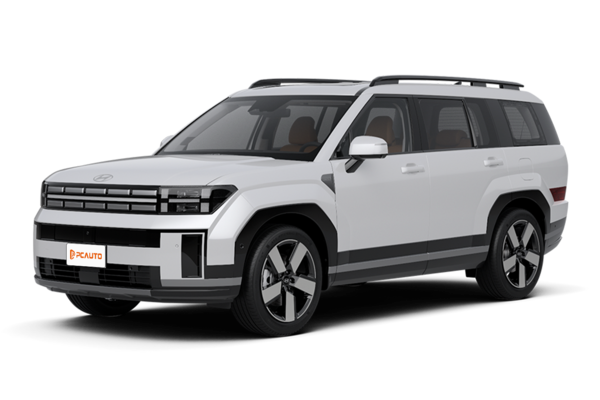Q
What is the best trim for the 2025 Santa Fe?
The 2025 Santa Fe hits Malaysian shores with a range of trims, and let's cut to the chase: the top-dog Calligraphy is the one to beat if you're after the full package. It's loaded with all the luxury and tech you could ask for – think a crisp 12.3-inch fully digital instrument cluster, a panoramic sunroof that floods the cabin with light, supple premium leather seats, a handy HUD for keeping your eyes on the road, and Hyundai's complete SmartSense active safety suite. That means goodies like Highway Driving Assist and Remote Smart Parking – perfect for folks who want both comfort and that high-tech edge.
If your budget's a bit tighter, don't sleep on the mid-range Premium trim. It still keeps the core comfort features we all appreciate, like dual-zone auto climate control and a user-friendly 10.25-inch infotainment screen. Plus, you're not skimping on safety here – it comes standard with practical stuff like blind-spot monitoring and rear cross-traffic collision avoidance.
Now, living in Malaysia, we all know how brutal that tropical heat can be, so it does a number on both your car's cooling and the interior's longevity. Trust me, splurging on the ventilated seats and UV-protected glass (if they're available as options in those tropical packs) is money well spent. On the upside, the Santa Fe does come standard with a smart air-con system and seats upholstered in heat-resistant materials, which should handle our local conditions pretty well.
And let's talk about our roads – they can be a bit unpredictable. If you can swing it, go for the HTRAC all-wheel-drive version. It'll definitely give you more confidence when things get slippery, especially during those sudden downpours. Also, if you're stuck in KL or PJ traffic day in, day out, the hybrid variant might just be your new best friend. It strikes a nice balance between decent fuel economy and peppy power when you need it most.
Special Disclaimer: This content is published by users and does not represent the views or position of PCauto.
Related Q&A
Q
What is the safety rating of the 2019 Hyundai Santa Fe?
The 2019 Hyundai Santa Fe delivers outstanding safety performance, earning top marks from leading evaluation agencies. It secured the IIHS "Top Safety Pick+" rating in the U.S. and a five-star Euro NCAP score in Europe—thanks to its rigid body structure, comprehensive active safety features, and advanced driver-assistance systems.
Standard equipment includes forward collision warning, automatic emergency braking, lane-keeping assist, and blind-spot monitoring. Higher trims add adaptive cruise control and rear cross-traffic alert for even greater protection.
Family-focused buyers can trust the Santa Fe’s safety credentials. Its high-strength steel construction effectively absorbs and disperses crash energy, while multiple airbags provide added security.
If you’re considering a used Santa Fe, don’t just rely on its safety ratings—check maintenance records and accident history to ensure all safety systems function properly. Even the best safety tech needs regular upkeep to perform at its best.
Q
Is the 2019 Hyundai Santa Fe all wheel drive?
The 2019 Hyundai Santa Fe does offer an all-wheel drive (AWD) variant, equipped with the HTRAC intelligent AWD system. This setup automatically distributes torque between the front and rear wheels based on road conditions, improving traction and stability on slippery surfaces or light off-road terrain.
In local markets, higher trim levels often come standard with AWD, while entry-level models may default to front-wheel drive—always check the vehicle's badge or spec sheet to confirm. Beyond handling wet weather with confidence, this AWD tech enhances safety on winding mountain roads. Hyundai's system uses electronic controls to seamlessly adjust power distribution between axles, balancing performance with fuel efficiency.
Keep in mind: AWD differs from traditional 4WD (built for rugged off-roading), as it prioritizes on-road agility. Buyers should weigh their typical driving needs. The Santa Fe's AWD also features selectable drive modes (Eco, Comfort, Sport) to adapt to different conditions.
Q
What is the recall on the 2019 Hyundai Santa Fe?
The 2019 Hyundai Santa Fe recall primarily addresses two critical issues. First, certain vehicles may have a software glitch in the anti-lock braking system (ABS) module, which could potentially increase stopping distances under specific conditions, raising collision risks. Hyundai is resolving this by rolling out a control module software update.
Second, some models may contain a hydraulic electronic control unit (HECU) with manufacturing defects that could lead to electrical shorts, posing a fire hazard. Dealers will inspect and replace affected components at no cost.
Recalls like these are proactive safety measures initiated by automakers. Owners can check their vehicle’s recall status by entering the VIN on Hyundai’s official website. Keep in mind, all car brands occasionally issue recalls due to supply chain issues or the complexity of modern electronics—it’s actually a sign of responsible manufacturing.
We recommend staying updated with brand service bulletins and completing recall repairs promptly. Most software updates or part replacements take just 30 minutes to 2 hours and won’t void your warranty. If you notice abnormal brake warning lights or a burning smell, contact an authorized service center immediately.
Q
Is the 2019 Santa Fe a reliable car?
The 2019 Santa Fe delivers decent reliability for a midsize SUV. Its proven 2.4L four-cylinder and 2.0L turbocharged engines provide smooth power delivery, while the transmission pairing is well-sorted. Major mechanical issues are uncommon in daily driving.
Owners report the suspension is tuned for comfort, making it family-friendly, and the interior materials/fit-and-finish are competitive for the segment. That said, some owners note occasional minor glitches with electronics—like infotainment screen lag—though these rarely affect drivability.
If buying used, always check the vehicle history or opt for units with complete maintenance records. Hyundai's quality has improved noticeably in recent years, and as their flagship SUV, the Santa Fe remains a generally dependable choice. Just remember—consistent maintenance and proper care go a long way in keeping it trouble-free.
Q
Is there any recalls on the 2019 Hyundai Santa Fe?
The 2019 Hyundai Santa Fe was subject to recall notices in certain markets due to potential safety concerns. These included possible short circuits in the brake system's hydraulic electronic control unit, which could reduce braking force, as well as necessary software updates for the anti-lock braking system (ABS) in some vehicles.
Owners are advised to check their vehicle's recall status using the VIN on Hyundai’s official website or through an authorized service center to ensure their vehicle meets the latest safety standards. As a good practice, regularly test your brake response and ABS functionality. If you notice a stiff brake pedal or warning lights, have it inspected immediately.
Hyundai operates a global recall system, with all repairs handled free of charge at authorized service points—just book an appointment. For used car buyers, verifying whether previous owners completed all recall fixes should be part of the pre-purchase checks.
Q
Is the 2019 Santa Fe reliable?
The 2019 Santa Fe delivers solid reliability overall. Its 2.4L and 2.0T engines are proven units, paired with either smooth-shifting 6-speed or 8-speed automatic transmissions that show low failure rates. Maintenance costs are reasonable for the segment.
You'll appreciate the spacious cabin and generous equipment, especially the safety tech like forward collision warning and lane keeping assist – these really boost confidence behind the wheel. That said, a few owners report occasional infotainment system glitches, so it's worth checking for software updates before purchase.
As a family SUV, the Santa Fe's durability sits above average in its class. Stick to the maintenance schedule and drive it right, and it'll serve you well for years. For used models, always review the full service history and pay extra attention to the undercarriage and electronics – these tell you more about the car's real condition than anything else.
Hyundai's build quality has come a long way, and this Santa Fe proves it. For practical buyers who want bang for their buck, it's a trustworthy choice.
Q
Does the 2019 Santa Fe have 3 rows?
The 2019 Santa Fe offers an optional third-row seating configuration in select markets, making it a seven-seater for family-oriented buyers. However, availability depends on trim levels and regional specifications—higher trims are more likely to include this feature.
As a midsize SUV, it prioritizes practicality, though the third row is best suited for children or occasional adult use on shorter trips. For extended journeys, adults may find it somewhat cramped. Competing models like the Toyota Fortuner or Honda CR-V also offer similar three-row layouts in this segment.
If you're considering the seven-seat version, we recommend test-driving to evaluate the third-row space firsthand. Also, keep in mind that additional seating may affect vehicle inspections and insurance policies. For frequent group travel, an MPV might be a better choice, as they typically provide more generous third-row accommodations.
Before purchasing, always verify the seating configuration with the dealer or check the spec sheet, as mid-cycle updates can sometimes alter available options.
Q
Does the 2019 Santa Fe have a sunroof?
Certain higher-trim 2019 Santa Fe models did come equipped with a panoramic sunroof, which significantly enhances cabin brightness and overall comfort. However, availability depends on the specific trim level purchased, as features vary across the range.
For sunroof maintenance, make sure to regularly clean the tracks and check that drainage holes are clear. Avoid prolonged sun exposure to prevent rubber seal deterioration—these simple steps can extend its lifespan. If you're considering a used Santa Fe, pay close attention to the sunroof's operation and check for any signs of water leakage, as these details often reveal how well the vehicle's been maintained.
While the sunroof does add to the enjoyment on road trips, drivers in hotter climates may find themselves using the sunshade more frequently to keep the cabin comfortable.
Q
What engine options did the 2019 Santa Fe offer?
The 2019 Santa Fe offers two engine options to suit different driving needs.
First up is the 2.4L naturally aspirated four-cylinder, delivering a solid 185 horsepower and 178 lb-ft of torque. It’s a great fit for daily city driving, with balanced fuel efficiency and smooth power delivery.
If you’re after more punch, the 2.0L turbocharged four-cylinder steps it up with 235 horsepower and 260 lb-ft of torque—perfect for drivers who want extra power for highway passing or loaded-up trips. Both engines pair with an 8-speed automatic transmission for seamless shifts.
As a midsize SUV, the Santa Fe strikes a nice balance between efficiency and performance. It also packs Hyundai’s latest safety tech at the time, like forward collision warning and lane-keeping assist, to help keep things secure on the road.
Quick note on the turbo: By forcing more air into the combustion chamber, it squeezes out extra power from the same displacement. Just remember—regular maintenance is key to keeping that turbo running smoothly for the long haul.
Q
Is the 2019 Hyundai Santa Fe AWD?
The 2019 Hyundai Santa Fe does offer an AWD variant, equipped with the HTRAC intelligent all-wheel-drive system. This SUV automatically distributes power between the front and rear axles based on road conditions, delivering better traction on slippery surfaces or during light off-roading. In local markets, both the high-spec 2.2L diesel and 2.4L gasoline models come with this system.
The AWD version features a drive mode selector on the center console, allowing you to switch between Eco/Comfort/Sport/Smart modes. In Smart mode, it adjusts power distribution dynamically by analyzing throttle input, steering angle, and other data. That said, this system is primarily designed for urban driving and light unpaved terrain—it’s not a hardcore off-road setup.
Competing Japanese models like the Honda CR-V and Toyota RAV4 use a similar clutch-based on-demand AWD, while German rivals often favor full-time AWD solutions. For buyers, the choice depends on usage: if you frequently encounter rainy conditions or occasional muddy job sites, the AWD version is more practical. But if you’re mostly driving in the city, the FWD model offers better fuel efficiency (saving around 5-8% in consumption) and value.
Latest Q&A
Q
How reliable is a 2019 Porsche Macan?
The 2019 Porsche Macan delivers solid reliability, thanks to its proven 2.0T or 3.0T engines that offer consistent power delivery. The PDK dual-clutch transmission is another strong point—it’s both durable and buttery-smooth.
Porsche’s sporty DNA shines through in the Macan’s chassis tuning and all-wheel-drive system, yet it doesn’t compromise everyday comfort. Owner feedback suggests that sticking to the factory maintenance schedule keeps most examples running trouble-free, though be prepared for higher upkeep costs (as with any luxury vehicle).
Its strong resale value speaks volumes about its reputation for dependability. If you’re after driving thrills without sacrificing SUV practicality, the 2019 Macan is a compelling pick. Just be sure to get a pre-purchase inspection and verify full service history—it’ll pay off in the long run.
Q
How much is a 2019 Porsche worth?
The value of a 2019 Porsche depends on the model, mileage, condition, and specs. Take the popular Cayenne, for example—used ones typically go for between RM300k to RM500k. A 911 Carrera might range from RM500k to RM800k, while an entry-level 718 Boxster or Cayman could be around RM250k to RM400k. For luxury sedans like the Panamera, expect prices between RM350k to RM600k, but always check the actual condition and option list.
Porsches hold their value well, especially limited editions or high-performance GT models, but maintenance costs and service history play a big role in resale pricing. If you're buying, stick to official certified pre-owned channels or get a professional inspection. Always verify warranty transfers and repair records.
Pro tip: Compare listings on local used-car platforms and check recent sales data—market demand and inventory fluctuations affect pricing. Also, factory options (like sport packages or premium audio) can boost resale value, while accident history or multiple owners might slash the price by 10-20%.
Q
Does the 2019 Macan have a good sound system?
The 2019 Porsche Macan delivers an impressive audio performance, particularly with the optional Bose® Surround Sound System or the top-tier Burmester® High-End Surround Sound System—both offering an immersive listening experience.
The Bose® setup packs 14 speakers with 665 watts of total power, delivering crisp audio and punchy bass perfect for pop and electronic music. Meanwhile, the Burmester® system steps it up with 16 speakers and 1,000 watts, creating a wider soundstage and superior detail reproduction—ideal for classical or high-resolution tracks.
Both systems integrate seamlessly with Porsche’s standard Communication Management (PCM), supporting Apple CarPlay and multiple audio sources. If sound quality is a priority, be sure to specify your audio preference at purchase—the base model only comes with a standard speaker setup.
For the best performance, play lossless files via USB or high-quality Bluetooth codecs, and keep the system firmware updated for optimal operation.
Q
What is the resale value of a 2019 Macan?
The resale value of a 2019 Porsche Macan depends on factors like condition, mileage, specs, and service history. Current used prices hover between RM250k to RM350k, with higher trims commanding premium prices. As Porsche's entry SUV, the Macan holds its value better than most rivals thanks to brand prestige and sporty DNA – especially models optioned with Sport Chrono or full leather interiors fetching stronger money.
Pro tip: Get a pre-sale inspection and organize your maintenance paperwork – this really helps maximize resale. Macans move quickly in our local used market, with 3-5 year-old examples being the sweet spot when depreciation levels off. If you're upgrading, consider Porsche Approved Certified pre-owned – you'll pay a slight premium over private sales, but the extended warranty and factory refurbishment save headaches down the road.
Q
Is a 2019 Porsche Macan a good car?
The 2019 Porsche Macan is a well-rounded luxury SUV that stays true to Porsche's performance DNA while delivering everyday practicality. It comes with your choice of a peppy 2.0T or more powerful 3.0T engine, paired with Porsche's brilliant 7-speed PDK transmission that shifts like butter. The chassis strikes that sweet spot between sporty handling and comfortable cruising - perfect for both city commutes and weekend backroad blasts.
Inside, you'll find Porsche's typical top-notch craftsmanship with a standard 10.9-inch touchscreen featuring Apple CarPlay. Just don't expect limo-like rear legroom. These things hold their value surprisingly well, though maintenance will cost you more than your average SUV - but then again, you get Porsche's excellent service network.
Among its competitors, the Macan stands out for its driver engagement. If you want more grunt, step up to the Macan S or GTS. One pro tip: if you're shopping used, pay special attention to the PDK's condition and inspect the suspension components. Always better to go through Porsche's certified pre-owned program for that extended warranty peace of mind.
View MoreRelated News

In Malaysia, which sliding door MPVs are available?
MichaelOct 30, 2025

Modern Ioniq 5 N Lands in Malaysia: Track-Level Performance Electric Vehicle is Here, Priced Possibly Below RM 400,000?
JohnSep 10, 2025

Hyundai's Big Return to Malaysia: Top 5 Models Expected
MichaelMay 30, 2025

580,000 km & 87.7% Battery Health: Ioniq 5’s Incredible Durability
MichaelMay 6, 2025

Revolutionizing Hybrids: Hyundai’s New System vs. Toyota's Hybrid System
Kevin WongApr 22, 2025
View More















Pros
Cons